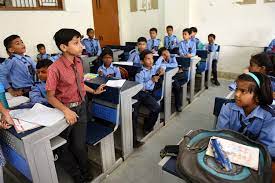The State of Primary Education in India:
Challenges and Prospects
Relevant for UPSC Mains GS 2 – Social Justice

Introduction: India, a diverse and vibrant country, is making strides in various sectors, including education. As the largest democracy in the world, India’s education system has a critical role in shaping the country’s future. Primary education is a crucial stage in a child’s life, as it lays the foundation for their overall development and future success. In this blog, we will explore the state of primary education in India, examine the challenges it faces, and discuss the prospects for improvement.
Primary Education in India: An Overview
Primary education in India typically refers to the education provided to children between the ages of 6 and 14. According to the National Education Policy (NEP) 2020, primary education is divided into two stages: the foundational stage (ages 3-8) and the preparatory stage (ages 8-11). Primary education in India is governed by both the central and state governments, with states having autonomy to frame their respective policies and curricula.
The Right to Education Act (RTE) of 2009 made education a fundamental right for every child between the ages of 6 and 14. The act mandates that all children receive free and compulsory primary education, regardless of their socio-economic background.
Challenges Facing Primary Education in India
Despite significant progress in primary education over the years, India still grapples with several challenges, including:
- Access to Education: While the RTE has ensured that primary education is accessible to all, there are still areas in India where children do not have access to adequate educational facilities. This issue is more pronounced in rural and remote areas, where schools may be far away or lacking basic infrastructure.
- Quality of Education: The quality of education provided in primary schools varies greatly across the country. Factors such as outdated teaching methods, lack of resources, and inadequate training for teachers contribute to this issue. Consequently, many students do not acquire the necessary foundational skills in reading, writing, and arithmetic.
- High Dropout Rates: Although enrollment rates in primary education have improved over the years, dropout rates remain a concern. Many children drop out of school due to factors such as poverty, child labor, early marriage, and inadequate infrastructure.
- Teacher Shortages: India faces a significant shortage of qualified and trained teachers. This issue is particularly acute in rural areas, where the student-to-teacher ratio is much higher than the recommended 30:1. Overburdened teachers often struggle to provide individual attention to students, impacting the quality of education.
- Inequality in Education: Socio-economic disparities, gender biases, and discrimination against marginalized communities often hinder access to quality primary education for all. Students from disadvantaged backgrounds may struggle to keep up with their peers, further exacerbating the inequality gap.
Prospects for Improving Primary Education in India
Despite these challenges, there are several promising developments and initiatives aimed at improving primary education in India:
- National Education Policy (NEP) 2020: The NEP 2020 aims to revamp the entire education system in India, with a focus on primary education. Some key initiatives include the introduction of a new curriculum framework, emphasis on foundational literacy and numeracy, and provisions for the professional development of teachers.
- Use of Technology: The integration of technology in primary education can help address issues related to access and quality. Initiatives such as e-learning platforms, digital libraries, and online teacher training programs are being implemented to bridge the gap between urban and rural schools.
- Public-Private Partnerships (PPPs): PPPs can play a vital role in improving primary education in India. Private players can contribute by providing resources, expertise, and innovative teaching methodologies. Successful examples of PPPs in primary education include successful examples of PPPs in primary education include the Akanksha Foundation, Teach for India, and the Central Square Foundation, among others.
- Community Involvement: Engaging local communities in the management and decision-making processes of primary schools can help address issues of access, quality, and infrastructure. Community participation can create a sense of ownership and accountability, leading to more sustainable outcomes for primary education.
- Focus on Inclusive Education: Policies and programs aimed at promoting inclusive education can help bridge the inequality gap. Initiatives such as scholarships for marginalized students, gender-sensitive curricula, and accessible infrastructure for students with disabilities can ensure that all children receive quality primary education.
Conclusion: Primary education is the bedrock of a nation’s development, and India is no exception. The challenges facing primary education in the country are manifold and complex, but they are not insurmountable. With concerted efforts from the government, private sector, non-governmental organizations, and local communities, India can overcome these challenges and create a robust primary education system that provides every child with a strong foundation for lifelong learning and success. By understanding the challenges and prospects of primary education in India, we can work collectively to ensure that all children receive the education they deserve. While progress has been made in recent years, there is still much work to be done. Let us join hands to create a brighter future for the children of India, and in turn, for the nation as a whole.

